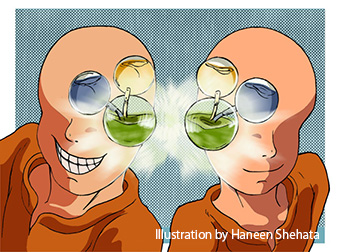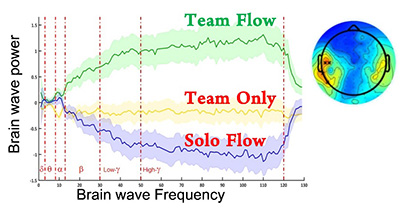
ここからコンテンツです。

The first neuroscience evidence of team flow as a unique brain state
Identification of team flow-specific neural activity by EEG brain imaging can be applied to predict and enhance team performance Mohammad Shehata
A research team led by associate professor, Mohammad Shehata at Toyohashi University of Technology, in cooperation with researchers at the California Institute of Technology and Tohoku University have discovered brain waves and regions associated with team flow (a state in which multiple people are functioning cooperatively in the "zone") by comparing them to teamwork unrelated to team flow, as well as to solo flow (a state in which individuals are in the "zone"). This study is the world’s first attempt to objectively study the psychological state of team flow. The potential application for these neural correlates may exceed the ability to understand and predict the experience of team flow. The authors aim to use their findings to monitor and predict the performance of teams.
Team flow is experienced when team players get "in the zone" to accomplish a task together. Great teams experience this psychological phenomenon, from sports to music bands and even professional work teams. When teamwork reaches the team flow level, one can observe the team perform in harmony, breaking their performance limits.
However, in order to scientifically investigate the team flow state, it is essential to reproduce and objectively measure the team flow state in the laboratory, and this has been the stumbling block to research for decades.

Researchers at the Electronics-Inspired Interdisciplinary Research Institute (EIIRIS) at Toyohashi University of Technology and California Institute of Technology found ways to break such hurdles and provide the first neuroscience evidence of team flow. The researchers used EEG to measure the individual brain activity of 10 two-person teams, while each team played a music video game together. In some trials, a partition separated the teammates so they couldn’t see each other while they played, allowing a solo flow state but preventing team flow. The research team scrambled the music into random sound sequences in other trials, which prevented a flow state but still allowed teamwork. The participants answered questions after each game to assess their level of flow. After the experiment, we compared the brain activity of the game players in the different states (solo flow, teamwork, and team flow). Then, the researchers compared the brain activity of the participants during each condition. They found a unique signature for team flow: increased beta and gamma brain waves in the middle temporal cortex, a type of brain activity linked to information processing. Teammates also had more synchronized brain activity during the team flow state compared to the regular teamwork state.

This study provides a methodology, based on neural models, that can be used for more effective team-building strategies in areas where human performance and pleasure matters - business, sports, music, performing arts, video games, and entertainment. In partnership with governmental and industrial institutions, the researchers plan to utilize the neural signature of team flow to monitor and enhance team performance and, perhaps, build more effective teams.
Enhancing performance while maintaining enjoyment may also lead to improved quality of life, including reduced incidence of depression, panic attacks, and anxiety.
This work is supported by following programs.
- The program for promoting the enhancement of research universities funded to Toyohashi University of Technology
- Grants-in-Aid for Scientific Research (Fostering Joint International Research(B), Grant Number 18KK0280)
- The Japan Science and Technology (JST)-CREST Grant Number JPMJCR14E4
- The University of Hong Kong postgraduate scholarship program.
- The University of Hong Kong General Research Fund.
- Australian Research Council Discovery Projects (DP180104128 and DP180100396).
- An Australian Government Research Training Program (RTP) Scholarship.
Reference
Mohammad Shehata, Miao Cheng, Angus Leung, Naotsugu Tsuchiya, Daw-An Wu, Chia-huei Tseng, Shigeki Nakauchi, and Shinsuke Shimojo (2021). Team flow is a unique brain state associated with enhanced information integration and inter-brain synchrony, eNeuro,
https://www.eneuro.org/lookup/doi/10.1523/ENEURO.0133-21.2021
世界初、チームが「ゾーン」に入ったときの脳活動が明らかに!
チームフロー特有の神経活動の発見はチームパフォーマンスの予測と強化に適用できるモハンマド シェハタ
豊橋技術科学大学 Mohammad Shehata准教授の研究チームは、カリフォルニア工科大学、東北大学の研究者らと協力して、チームフロー(複数の人間が協調して「ゾーン」に入った状態)に関係する脳波と領域を、チームフローに関係のないチームワークやソロフロー(個人が「ゾーン」に入った状態)と比較することで発見しました。この研究は、チームフロー時の心理状態を客観的に研究する世界初の試みです。今回発見したチームフローと脳活動の相関は、チームフロー体験の理解と予測に利用できるだけではありません。研究者らは、今回の研究成果をチームのパフォーマンスのモニタリングや予測に活用することを目指しています。
チームフローとは、チームのメンバーが協調して「ゾーン」に入って一緒にタスクを達成するときに経験する状態です。チームがチームフローの状態にあるとき、通常の限界を超えて調和のとれた極めて高いパフォーマンスを発揮することがあります。サッカーやバレーボールなどのスポーツやダンスチーム、音楽バンド、さらにはプロの仕事のプロジェクトチームなど、優れたチームはこの心理的現象を経験しています。
チームフロー状態を科学的に調べるためには、チームフローの状態を実験室で再現し、客観的に測定することが不可欠ですが、これは何十年もの間大きな課題となっていました。
豊橋技術科学大学エレクトロニクス先端融合研究所とカリフォルニア工科大学の研究者らは、この問題を克服する方法を発見し、チームフローの神経科学的な証拠を初めて明らかにしました。研究チームは、実験参加者が2人1組で音楽ビデオゲームをプレイしているとき、それぞれのプレーヤーの脳波を同時に測定しました。実験ではフロー状態をコントロールするために、通常のプレイ環境の他に、プレイ中にお互いの顔が見えないようにパーティションで区切り、ソロのフロー状態は可能だがチームでのフローは不可能な状態にしたり、音楽を編集してランダムな音列にすることで、フロー状態になることが不可能でチームワークを保つことは可能な状態にしました。実験参加者に各ゲームの後に質問に答えてもらい、フロー状態のレベルを評価しました。
実験後、さまざまな状態(ソロフロー、チームワーク、チームフロー)にあるゲームプレイヤーの脳活動を比較しました。その結果、チームフローの状態では中側頭皮質で、ベータ波とガンマ波が増加していることが判明しました。また、チームフロー状態では通常のチームワーク状態に比べて、チームメイトの脳活動がより強く同期することもわかりました。
本研究は、ビジネス、スポーツ、音楽、舞台芸術、ゲーム、エンターテインメントなど、人のパフォーマンスや喜びが重要な分野において、脳神経モデルに基づいたより効果的なチームビルディング戦略に活用できる方法論を提供するものです。研究者らは、政府機関や産業界と協力して、チームのパフォーマンスをモニタリングしたり強化したりすることによって、さらに効果的なチームを構築するために、本研究成果を活用することを計画しています。
また、楽しさを維持しながらパフォーマンスを向上させることは、うつ病やパニック障害、不安症の発生率を低減するなど、生活の質の向上につながる可能性があります。
本研究は,次の助成を受けて行われています。研究大学強化促進プログラム(豊橋技術科学大学)、科学研究費補助金(国際共同研究(B),助成番号18KK0280),日本科学技術振興機構(JST)-CREST助成番号JPMJCR14E4、香港大学一般研究費、オーストラリア研究評議会のディスカバリー・プロジェクト(DP180104128およびDP180100396)、オーストラリア政府の研究者育成プログラム(RTP)奨学金
Researcher Profile

| Name | Mohammad Shehata |
|---|---|
| Affiliation | Electronics-Inspired Interdisciplinary Research Institute(EIIRIS) |
| Title | Associate Professor |
| Fields of Research | Neuroscience |
ここでコンテンツ終わりです。
